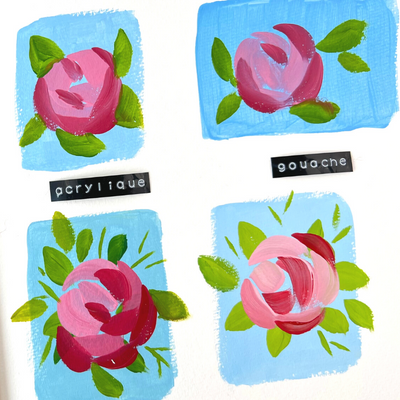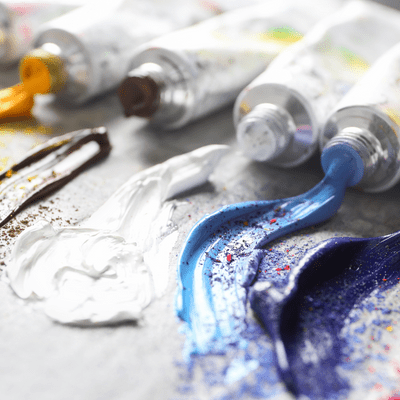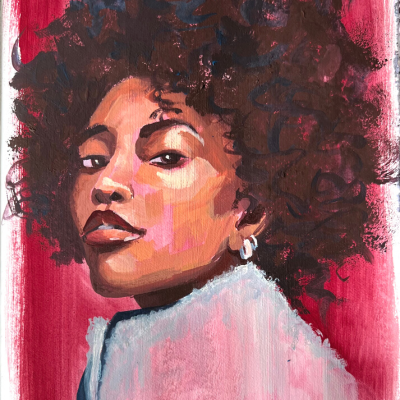Gouache vs. oil paints
Some people are confused about whether they should use oil or gouache. They are both opaque mediums but require a different approach. In this article, we’ll look at the pros and cons of gouache vs. oil paints so that you can decide which is best for your style and needs.
Components.
Gouache is made of pigments, binders, and fillers, and it is water-based. This means it is more forgiving for beginners, as you don’t need to worry about thinning it down before you use it. It also means that clean-up will be easier and quicker for you and safer for the kids who may want to join in on your art projects! Gouache is a medium that painters can use in many different ways. It’s opaque and water-based, making it easy to apply with a brush or a spatula and smooth without cracking. It also doesn’t have an odor, making it ideal for indoor use and for those who suffer from allergies.
Oil paints are made of pigments and linseed oil. There are water-based versions of oil paint, but it’s more that they can be cleaned with water than made with water. In this article, I’m talking about traditional oil paints. Oil paints are made with linseed oil, which is a drying oil. This means that it takes longer to dry than water-based media, but it also means that it will not warp or crack when exposed to changes in humidity or temperature. This is important if you want your paintings to last many years.
Chemicals.
Gouache paint is diluted and cleaned with tap water. When painting with oil paints, you may add different mediums, oils, and gels to change the paint, and you’ll need turpentine to clean your brushes. So if you’re concerned about allergies and toxicity, you may avoid oil paints.
Drying time.
Gouache dries fast—it is a significant reason why gouache is so popular. It can take less than a minute to dry, so you don’t have to wait for your color layers to dry before applying another layer of paint. This is great if you’re trying to build up layers of color quickly or if you want bright colors in your painting. But it has downsides: if you paint outside, the weather can be a huge problem. Too cold, and the gouache will freeze. Too hot, and it will dry in the palette.
Oil paints take a few days to years to dry, depending on the weather. They never ‘dry’, they harden. This can be frustrating for painters who are used to gouache and acrylics, which dry very quickly. But it’s great for blending and fixing mistakes, as the paint stays fresh for a long time. You can add mediums to shorten the drying time, like Liquin.

Surfaces to paint on.
You can apply gouache on different substrates: paper, canvas, wood, cardboard… without any preparation. You just need a substrate that can handle a minimum amount of water, and you’re good to go. As gouache dries fast, you can paint in sketchbooks easily. The only thing you have to watch out for is the texture of your substrate. It can be challenging to paint on rough surfaces like stone or canvas, and you may want to use a smoother surface.
Being made with oil, you need to prepare the surface you’re painting on for oil paints by priming it with gesso, a white acrylic paint. In addition to making the surface smooth, gesso also acts as an adhesive to hold paint in place and prevent oil from diffusing the substrate. I’ve tried to use oil paints directly on regular paper, and the oil will bleed! You can use oil canvas paper, which is prepared for oil painting and won’t bleed. This is what I’m using in the video at the end of this article.
Shift in values.
Although both paints dry to an opaque finish, gouache dries slightly lighter because it contains more chalk and less oil than oil paints. The color difference can be subtle, but you might need to adjust your painting with this in mind once finished.
Size of tubes.
Gouache is a water-based paint that painters can use in much the same way as traditional oil paints. It comes in tubes similar to oil paints, but because gouache is thinner and less dense than oil, it’s easier to control on canvas. The thinner consistency also makes gouache more portable; you can carry them around in your pocket or bag instead of taking a whole box with you wherever you go!
Oil paint tubes are larger and less portable than gouache tubes. While you can easily find a single tube of gouache paint at any art supply store, oil paints are sold in large tubes that are more difficult to carry around in your bag or purse.

Price of paint.
Gouache has a medium price of US$47 per 100 ml (you can see here how I calculated this). Oil is more expensive, depending on the brands, and you also have to incorporate the price of mediums, particular substrates, and gesso. So I would say the overall cost per square meter is more expensive with oil paints.
While they’re more expensive than gouache tubes, oil paints can produce richer colors and offer a longer drying time, allowing you to work with them less urgently.
Ease to learn and use
Gouache is much easier to learn and use than oil paints. You only need a brush, some paper, and gouache tubes. There is no need to mix with mediums or special substrates, and no need for gesso or any other prepping step before painting. You have to learn how to mix colors and get started! It’s also much easier to clean up after using gouache. Gouache is more practical than oil paints, especially when you want to paint on the go. The small tubes are easy to carry around and don’t require mixing mediums or special equipment other than a brush.
Oil paints can catch the light and have rich colors that make them fun to experiment with. You can achieve many different effects with oil paint with various techniques and mediums, from impasto to glazing.
Conclusion
To summarize, you should choose gouache if you are looking for a cheaper alternative to oil painting that works well on paper and has bright colors. You should select oil paints if you want something that dries slowly so you can work with it over time or if your work requires more layers than gouache allows.
You can watch this video where I compare gouache and oil paints:









